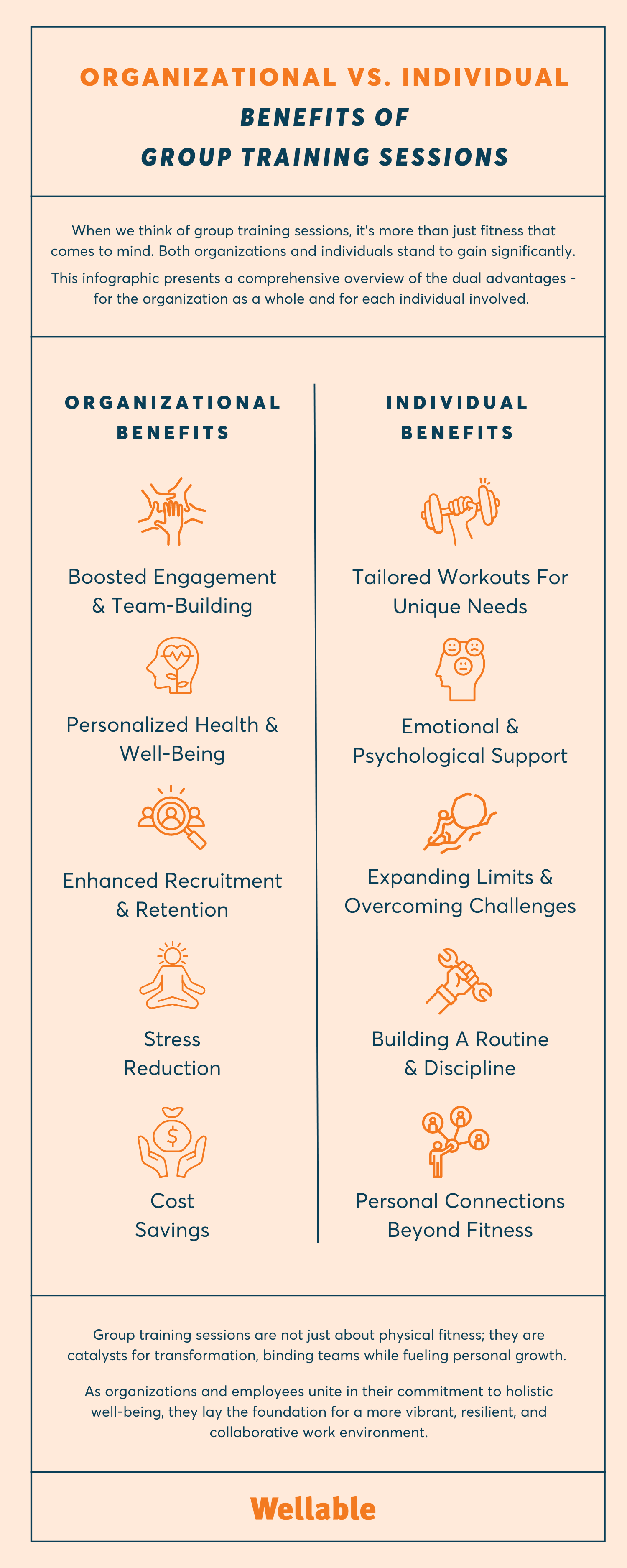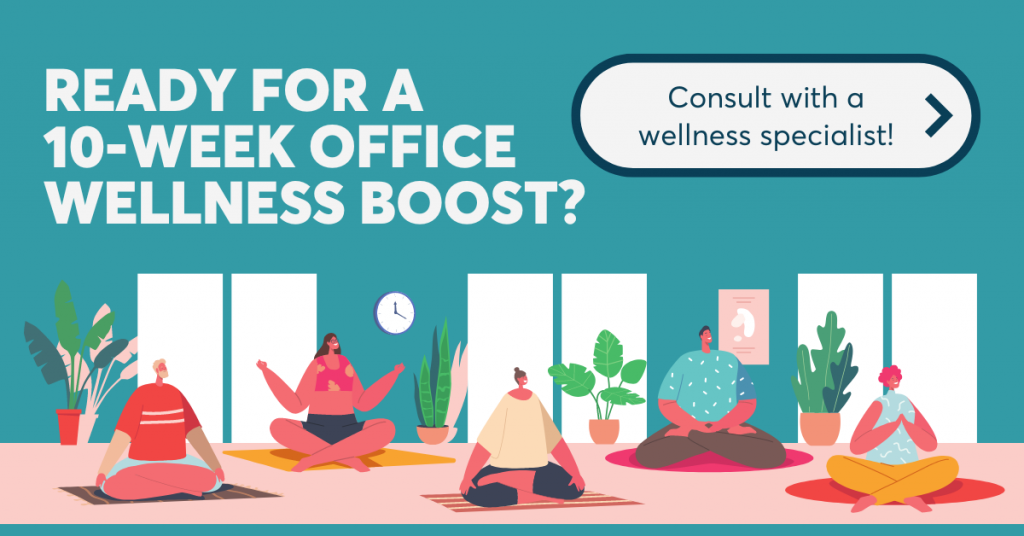As employers continue to refine post-pandemic return-to-office (RTO) strategies, they’re confronted with new realities. Today’s corporate landscape is characterized by hybrid work models, a continued focus on employee well-being, and maintaining company culture with a dispersed or semi-dispersed team. How can organizations structure their RTO policies and employee benefits to align with these evolving expectations?
Recent data from corporate wellness company HealthFitness reveals a resurgence of on-site fitness classes, emphasizing how personal health and meaningful interactions have risen to the forefront of employees’ priorities. Far from a mere “perk,” offering group training sessions can serve as a testament to an organization’s most valuable asset – its people. More importantly, they’re a smart investment in a comprehensive and people-centric RTO strategy.
This article covers the role of group fitness in addressing post-pandemic challenges, the organizational and individual benefits of training sessions, and how to successfully integrate them into an RTO plan.
Pressed for time? Here’s a quick summary…
- Surge in personal & group training: According to HealthFitness, 77% of employees are signing up for four to eight personal or group training sessions per month. 86% of these sessions are held in–person at corporate gyms.
- Organizational benefits: Group training sessions offer a range of organizational benefits, spanning heightened productivity and team cohesion to lower absenteeism and turnover rates.
- Individual benefits: The primary benefits of on-site fitness classes are cost and convenience since employees can easily incorporate fitness into their daily routine at no or low cost.
- Integration into RTO strategy: Offering group fitness can be a powerful motivation for employees to come back to the office, providing a platform for social engagement and physical activity.
A Resurgence Of The Corporate Gym In A Post-Pandemic World
The pandemic drastically altered the work landscape, with the isolation and prevalence of remote work prompting lasting changes to daily routines and social interactions. As the world gradually regains a sense of normalcy, the longing for in-person connection finds a refuge in an unexpected place: the corporate gym.

The Intersection Of Socialization & Personal Health
HealthFitness reports a surge in personal and group training, with 86% of sessions conducted in-person since the pandemic began to subside. While many workers value the benefits of remote work and have grown accustomed to its flexibility, they continue seeking a different kind of fulfillment – connections and experiences beyond the digital realm.
This trend is clear: 77% of employees are registering for four to eight personal or group training sessions every month. This level of interest and commitment in corporate fitness classes not only indicates a strong demand but also provides insights into the optimal frequency for offering classes when launching a new employer-sponsored fitness program.
Rebuilding Office Culture
Group fitness sessions have demonstrated the ability to rekindle office culture, which has taken a hit due to the rise of remote work. They nurture interactions not only within teams but also across departments, creating connections and networking opportunities that might not organically occur within the confines of standard work routines.
Mental Health & Work-Life Balance

The benefits of group fitness classes extend beyond camaraderie. With nearly three-quarters of employees battling burnout, these sessions can play a pivotal role in nurturing work-life balance. Exercise can enhance mental health, offering employees an outlet to tackle stress, anxiety, and other mental strains lingering from the pandemic and exacerbated by the unfamiliarity of returning to the office.
Balancing The Power Of In-Person Sessions With Accessibility
The data suggests that only 5% of personal and group training sessions are held virtually. This emphasizes that in-person sessions, with their personal touch and shared physical space, offer advantages that remote training may not fully replicate.
However, with 35% of the workforce still working remotely full-time, on-demand classes provide an avenue for employees to nurture their well-being and connect virtually. On-site group fitness classes could complement a virtual-only solution that is more accessible to remote employees.
5 Organizational Benefits Of Group Training Sessions
Group training sessions offer a range of practical benefits that can have a profound impact on organizational success.

1. Boosted Engagement & Team-Building
In-person group training sessions form real connections in the tangible world, fostering camaraderie and relationships that extend beyond conventional work environments. These interactions also facilitate networking and bolster team morale, contributing to a more connected and motivated workforce.
2. Personalized Health & Well-Being
Tailored fitness programs based on individual needs provide a comprehensive approach to enhancing physical well-being. The positive impact extends to mental focus, overall health, and the subsequent reduction in sick days, resulting in increased productivity.
3. Enhanced Recruitment & Retention

Offering training sessions showcases an organization’s commitment to employee well-being. This can aid:
- Recruitment Efforts: Potential hires may be attracted to the company’s dedication to fostering work-life balance and employee well-being.
- Employee Retention: Current employees are likely to stay with a company that displays authentic care for their well-being and personal growth.
4. Stress Reduction
Engaging in challenging workouts builds mental resilience, arming employees with the capacity to tackle workplace hurdles with greater composure and ease. Group training sessions can also integrate stress reduction techniques like mindfulness and meditation through practices such as yoga, providing employees with coping strategies for difficult times.
5. Cost Savings
Training programs generate a substantial return on investment by indirectly contributing to fewer common illnesses, thereby strengthening the immune system and enhancing overall employee health. This results in reduced healthcare claims for larger organizations, alongside increased productivity, decreased absenteeism, and improved employee retention, making these sessions an economically sound long-term investment.
The Personal Touch: 5 Individual Benefits Of Group Training
While the organizational advantages of group training sessions are undeniable, considering the benefits on an individual level provides a deeper perspective on their impact. These sessions cater not just to physical fitness but also to emotional well-being, psychological resilience, and personal growth.

1. Tailored Workouts For Unique Needs
A one-size-fits-all approach to health falls short of addressing individual needs and preferences. Personalization is key for employees to harness their full potential. Individuals aiming to improve certain aspects of their physical health, such as cardiovascular endurance or muscle strength, benefit from workouts tailored to these goals. Additionally, those with medical considerations can engage in specific exercises that avoid strain.
2. Emotional & Psychological Support
Beyond the physical gains, fitness sessions are tools for nurturing emotional and psychological well-being. Engaging in exercise triggers the release of endorphins, often referred to as “feel-good” hormones. This natural chemical reaction within the body boosts mood and feelings of contentment, leading to a more optimistic outlook and emotional balance.
3. Expanding Limits & Overcoming Challenges
Training sessions encourage participants to push their limits and embrace challenges, creating a culture of growth and resilience. As employees achieve their fitness goals, this sense of self-confidence can extend beyond the gym. From approaching work tasks with newfound enthusiasm to learning a new skill they were once hesitant to try, the impact of pushing their abilities can become a transformative force in employees’ lives.
4. Building A Routine & Discipline
Regular participation in training sessions bolsters accountability as employees honor their scheduled workout times. This commitment to a fitness regimen instills a habit-forming mindset that can be applied to various aspects of life. Just as employees show up for their training sessions, they develop a similar sense of responsibility towards personal goals, whether it’s dedicating time to family or embracing self-care routines. This discipline drives both professional success and personal fulfillment.
5. Personal Connections Beyond Fitness
Group training sessions foster connections through shared challenges, successes, and moments of perseverance. Mutual encouragement and support form a sense of community that contributes to employees’ social wellness.

Ideas For Implementing Group Training Sessions In RTO Strategy
When incorporating group training sessions into a RTO strategy, a thoughtful approach can maximize engagement in the program and serve as a compelling incentive for employees to embrace the transition.

- Survey Employees’ Preferences: Before launching, gather insights into employees’ interests, timing preferences, and desired workout styles. Understanding their preferences ensures that the sessions cater to their needs and signals that their input matters in shaping the office culture.
- Collaborate With Experienced Vendors: Partner with reputable wellness professionals to provide fitness classes suitable for all fitness levels. This provides employees with diverse and welcoming fitness opportunities.
- Hybrid Model Of Training: Recognizing that some employees may feel uncomfortable with in-person participation, offering both in-person and virtual sessions enhances accessibility. This ensures that employees have the flexibility to join from a comfortable setting, while also having the freedom to choose office participation without pressure.
- Specialized Team-Building Sessions: As employees continue seeking both meaningful connections and enhanced physical well-being, using training sessions as team-building opportunities can make the return to the office more enticing. Consider incorporating group exercises like relay races and paired workouts. Additionally, theme-based days, like “Yoga Fridays” or “Cardio Mondays”, add a sense of fun to a workout regimen.

- Flexible Scheduling: Accommodate varying schedules by offering sessions at different times throughout the day. Whether employees are early birds seeking an energizing start to their workdays or prefer an unwinding session in the evening, this approach ensures accessibility for all. Additionally, provide on-demand recordings for those unable to attend live.
- Mindfulness & Stress-Relief Workouts: Combine physical activity with mindfulness practices like yoga or tai chi. Previously remote employees may feel uneasy about returning to the office, and providing mindfulness techniques can help cope with stress.
- Incentive Programs: Encourage consistent participation with rewards and recognition. Lifestyle spending accounts, for example, serve as an incentive for in-office participation by crediting extra wellness dollars to active attendees, which can then be spent on health-related rewards.
- Fitness Challenges & Leaderboards: Wellness challenges and leaderboards can spark friendly competition and spike motivation. These components entice employees to regularly participate and build workplace connections.
- Educational Workshops: Offer workshops on nutrition, stress management, and financial wellness. Expanding beyond fitness demonstrates an organization’s commitment to employees’ holistic well-being, showcasing the office as a place where growth opportunities extend beyond the professional realm.
- Continuous Feedback Loop: Regularly gather feedback to refine and enhance the training programs based on employees’ preferences and needs. This fosters a sense of ownership among participants, spurring engagement.
- Celebrate Success Stories: Showcase employees who have experienced positive changes in their physical and mental health as a result of the sessions. Sharing their stories inspires others and reinforces the program’s significance.

10-Week Group Training Blueprint For Employers
Consistency is key when it comes to building a habit, and the same principle applies to corporate wellness initiatives. It’s recommended that companies offer a fixed 10-week schedule for group training sessions. This allows employees to plan ahead and incorporate these classes into their busy lives, thereby increasing participation rates and maximizing the benefits of a regular fitness routine.
Below is a sample 10-week training calendar featuring two popular class offerings, best suited for a diverse employee base.

Weeks 1-10
Every Tuesday at 12:30pm:
- Stretch (45 min): Boost your flexibility and muscle strength with guided, gentle movements. This class not only improves muscle tone but also alleviates pain, minimizes injury risk, and relaxes the mind.
Every Thursday at 5:00pm:
- Cardio Kickboxing (45 min): Elevate your fitness with a high-energy workout synced to upbeat music. This class offers a comprehensive routine, including warm-up, fresh weekly combinations for upper and lower body, core work, and a cool-down. Adapted for all ages and fitness levels.
With a steady 10-week schedule in place, employees can look forward to regular and dependable workout sessions. This consistency also allows for a more accurate assessment of the program’s impact on employee wellness and engagement.
At the end of this 10-week period, gather feedback from participating employees to understand their experiences and preferences. These insights can be used to curate the next 10-week calendar, potentially introducing new types of classes while maintaining the essence of the program’s initial success.
This cycle of consistency and evaluation is essential for sustaining an impactful corporate fitness program, fostering both physical health and a sense of community within the workplace.













